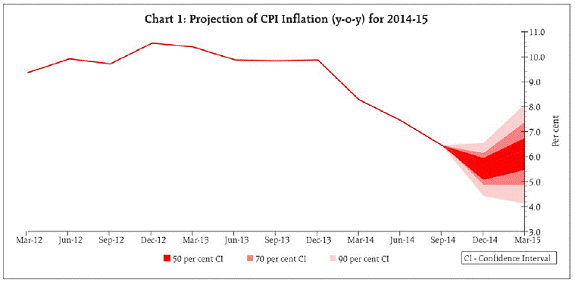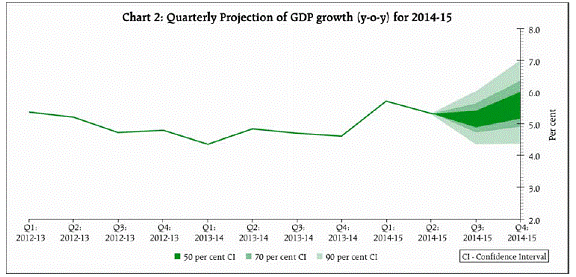Monetary and Liquidity Measures
On the basis of an assessment of the current and evolving macroeconomic situation, it has been decided to:
a. keep the policy repo rate under the liquidity adjustment facility (LAF) unchanged at 8.0 per cent;
b. keep the cash reserve ratio (CRR) of scheduled banks unchanged at 4.0 per cent of net demand and time liabilities (NDTL);
c. continue to provide liquidity under overnight repos at 0.25 per cent of bank-wise NDTL at the LAF repo rate and liquidity under 7-day and 14-day term repos of up to 0.75 per cent of NDTL of the banking system through auctions; and
d. continue with daily one-day term repos and reverse repos to smooth liquidity.
Consequently, the reverse repo rate under the LAF will remain unchanged at 7.0 per cent, and the marginal standing facility (MSF) rate and the Bank Rate at 9.0 per cent.
Assessment of the Global Economy
2. Since the fourth bi-monthly monetary policy statement of September 2014, the global economy has slowed, though the recent sharp fall in crude prices will have a net positive impact on global growth. The recovery in the United States is broadening on the back of stronger domestic consumption, rising investment and industrial activity. In the Euro area, headwinds from recessionary forces continue to weaken industrial production and investment sentiment. In Japan, growth may be picking up again on the back of stronger exports, helped in part by further quantitative and qualitative easing that has led to a depreciation of the yen. In China, disappointing activity and still-low inflation have prompted rate cuts by the People’s Bank of China. In other major emerging market economies (EMEs), downside risks to growth from elevated inflation, low commodity prices, deteriorating labour market conditions and stalling domestic demand have become accentuated.
3. Notwithstanding the cessation of asset purchases by the US Fed, financial markets have remained generally buoyant on abundant liquidity stemming from accommodative monetary policies in the advanced economies (AEs). The search for yield has driven global equity markets to new highs, with investors shunning gold and commodities. Capital flows to EMEs recovered from market turbulence in the first half of October, although some discrimination on the basis of fundamentals is becoming discernible.
Assessment of the Indian Economy
4. Domestic activity weakened in Q2 of 2014-15, and activity is likely to be muted in Q3 also because of a moderate kharif harvest. The deficiency in the north-east monsoon rainfall has constrained the pace of rabi sowing, except in the southern States. Despite reasonable levels of water storage in major reservoirs, the rabi crop is unlikely to compensate for the decline in kharif production earlier in the year and consequently, agricultural growth in 2014-15 is likely to be muted. This, along with a slowdown in rural wage growth, is weighing on rural consumption demand.
5. Despite the uptick in September, the growth of industrial production slumped to 1.1 per cent in Q2 with negative momentum in September, unable to sustain the improvement recorded in the preceding quarter. The persisting contraction in the production of both capital goods and consumer goods in Q2 reflected weak aggregate domestic demand. However, more recent readings of core sector activity, automobile sales and purchasing managers’ indices suggest improvement in likely activity. Exports have buffered the slowdown in industrial activity in Q2 but, going forward, require support from partner country growth.
6. In the services sector, the October’s purchasing managers’ survey indicates deceleration in new business. In contrast, tourist arrivals and domestic and international cargo movements have shown improvement. Thus, various constituents of the services sector are emitting mixed signals.
7. A rise in investment is critical for a sustained pick-up in overall economic activity. While low capacity utilisation in some sectors is a dampener, the recent strong improvement in business confidence and in investment intentions should help. In this context, the still slow pace of reviving stalled projects, despite government efforts, warrants policy priority, even as ongoing efforts to ease stress in the financial system unlock resources for financing the envisaged investment push.
8. The fiscal outlook should brighten because of the fall in crude prices, but weak tax revenue growth and the slow pace of disinvestment suggest some uncertainty about the likely achievement of fiscal targets, and the quality of eventual fiscal adjustment. The government, however, appears determined to stay on course.
9. Retail inflation, as measured by the consumer price index (CPI), has decelerated sharply since the fourth bi-monthly statement of September. This reflects, to some extent, transitory factors such as favourable base effects and the usual softening of fruits and vegetable prices that occurs at this time of the year. On the other hand, protein-rich items such as milk and pulses continue to experience upside pressures, reflecting structural mismatches in supply and demand. The absence of adequate administered price revisions in inputs like electricity has contributed to the easing of inflation in the fuel group.
10. In the non-food non-fuel category, inflation eased broadly in September. Further softening of international crude prices in October eased price pressures in transport and communication. However, upside pressures persist in respect of prices of clothing and bedding, housing and other miscellaneous services, resulting in non-food non-fuel inflation for October remaining flat at its level in the previous month, and above headline inflation. Survey-based inflationary expectations have been coming down with the fall in prices of commonly-bought items such as vegetables, but are still in the low double digits. Administered price corrections, as and when they are effected, weaker-than-anticipated agricultural production, and a possible rise in energy prices on the back of geo-political risks could alter the currently benign inflation outlook significantly.
11. Liquidity conditions have eased considerably in Q3 of 2014-15 due to structural and frictional factors, as well as the fine tuning of the liquidity adjustment framework. With deposit mobilisation outpacing credit growth and currency demand remaining subdued in relation to past trends, banks are flush with funds, leading a number of banks to reduce deposit rates. The main frictional source of liquidity has been the large release of expenditure/transfers by the government. In view of abundant liquidity, banks’ recourse to the Reserve Bank for liquidity through net fixed and variable rate term and overnight repos and MSF declined from `803 billion, on average, in Q1 to`706 billion in Q2 and further to `476 billion in October-November. The use of export credit refinance also declined from 52.6 per cent of the limit in Q2 to 32.6 per cent in October-November. The revised liquidity management framework introduced in September, has helped the weighted average cut-off rates in the 14-day term repo auctions as well as in the overnight variable rate repo auctions to remain close to the repo rate, and the volatility of the weighted average call rate has fallen, apart from episodes of cash build-up ahead of Diwali holidays.
12. The Reserve Bank determines the need for open market operations (OMO) based on its assessment of monetary conditions rather than on a specific view on long term yields. On an assessment of the permanent liquidity conditions, the Reserve Bank conducted OMO sales worth `401 billion during October to December so far.
13. Merchandise exports declined in October, mainly reflecting sluggish external demand conditions, but also the softening of international prices resulting in lower realisations. For the period April-October as a whole, however, export growth remained positive although the deceleration since July requires vigilance. With import growth remaining modest on account of the decline in POL imports due to falling crude prices, the trade deficit narrowed from its level a year ago. Gold imports have surged since September in volume terms, largely reflecting seasonal demand. Barring month-to-month variations, non-oil non-gold import growth has remained moderate, with anecdotal evidence of imports substituting for shortfalls in domestic production. Even as external financing requirements stay moderate, all categories of capital flows, except non-resident deposits, have been buoyant. The consequent accretion to reserves denominated in US dollars has been moderated by valuation effects resulting from the strength of the US dollar.
Policy Stance and Rationale
14. Consistent with the balance of risks set out in the fourth bi-monthly monetary policy statement of September, headline inflation has been receding steadily and current readings are below the January 2015 target of 8 per cent as well as the January 2016 target of 6 per cent. The inflation reading for November – which will become available by mid-December – is expected to show a further softening. Thereafter, however, the favourable base effect that is driving down headline inflation will likely dissipate and inflation for December (data release in mid-January) may well rise above current levels.
15. The key uncertainty is the durability of this upturn. The full outcome of the north-east monsoon will determine the intensity of price pressures relating to cereals, oilseeds and pulses, but it is reasonable to expect some firming up of these prices in view of the monsoon’s performance so far and the shortfall estimated for kharifproduction. Risks from imported inflation appear to be retreating, given the softening of international commodity prices, especially crude, and reasonable stability in the foreign exchange market. Accordingly, the central forecast for CPI inflation is revised down to 6 per cent for March 2015 (Chart 1).

17. Some easing of monetary conditions has already taken place. The weighted average call rates as well as long term yields for government and high-quality corporate issuances have moderated substantially since end-August. However, these interest rate impulses have yet to be transmitted by banks into lower lending rates. Indeed, slow bank credit growth is mirrored by increasing reliance of large corporations on commercial paper and domestic as well as external public issuances.
18. Still weak demand and the rapid pace of recent disinflation are factors supporting monetary accommodation. However, the weak transmission by banks of the recent fall in money market rates into lending rates suggests monetary policy shifts will primarily have signaling effects for a while. Nevertheless, these signaling effects are likely to be large because the Reserve Bank has repeatedly indicated that once the monetary policy stance shifts, subsequent policy actions will be consistent with the changed stance. There is still some uncertainty about the evolution of base effects in inflation, the strength of the on-going disinflationary impulses, the pace of change of the public’s inflationary expectations, as well as the success of the government’s efforts to hit deficit targets. A change in the monetary policy stance at the current juncture is premature. However, if the current inflation momentum and changes in inflationary expectations continue, and fiscal developments are encouraging, a change in the monetary policy stance is likely early next year, including outside the policy review cycle.
19. While activity appears to have lost some momentum in Q2, probably extending into Q3, conditions congenial for a turnaround – the softening of inflation; easing of commodity prices and input costs; comfortable liquidity conditions; and rising business confidence as well as purchasing activity – are gathering. These conditions could enable a pick-up in Q4 if coordinated policy efforts fructify in dispelling the drag on the economy emanating from structural constraints. A durable revival of investment demand continues to be held back by infrastructural constraints and lack of assured supply of key inputs, in particular coal, power, land and minerals. The success of ongoing government actions in these areas will be key to reviving growth and offsetting downside risks emanating from agriculture – in view of weaker-than-expected rabisowing – and exports – given the sluggishness in external demand. Anticipating such success, the central estimate of projected growth for 2014-15 has been retained at 5.5 per cent, with a gradual pick-up in momentum through 2015-16 on the assumption of a normal monsoon and no adverse supply/financial shocks (Chart 2).

Alpana Killawala
Principal Chief General Manage







 CAclubindia
CAclubindia
